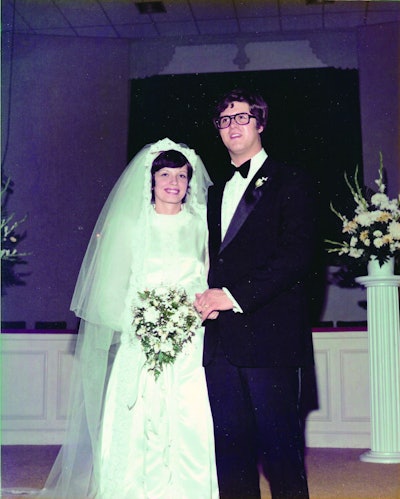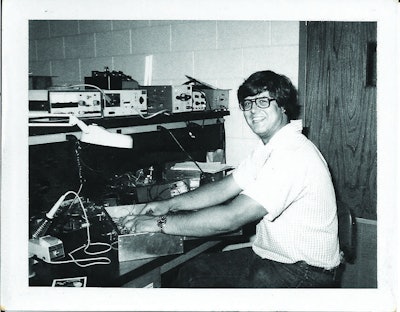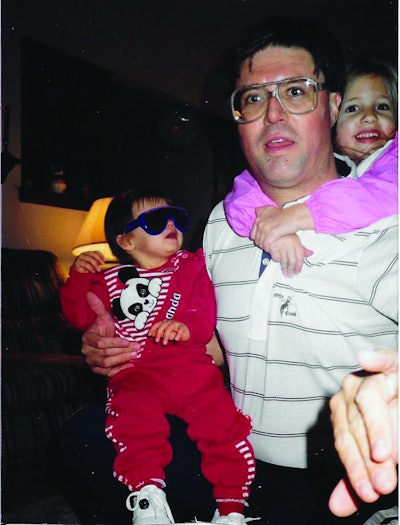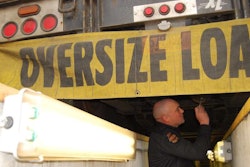 Jerry Thrift, 1952-2013
Jerry Thrift, 1952-2013It was an ending no one foresaw. Mere weeks after being diagnosed with an aggressive brain tumor, Jerry Thrift – a giant of a man with an outsized passion for learning, mentoring and sharing his love of the science of maintenance – was gone.
Thrift’s co-workers at Ryder System and industry colleagues at The Technology and Maintenance Council were shocked not only at the suddenness of his death but also at the void left by this quiet but influential individual and left to consider his accomplishments.
For his wife of 39 years, Pat, and their daughters, Micah and Kortney, and granddaughter, Harper, the loss was profound: a father and – now – a grandfather gone far too soon. But if anything, Jerry Thrift had been unselfish with every aspect of his outsized heart and personality. He’d had a worldview that focused on both faith and family. In Thrift’s outsized embrace, “family” included not just Pat and his beloved daughters, but also his company and an entire industry.
Formative years
Born in 1952, Thrift was the eldest son of a working-class family in Savannah, Ga. His father, Foster, was a boilermaker at the local paper mill, while his mother, Reba, was a homemaker until Jerry and his younger brother, Ricky, were older, when she reentered the workforce as an administrative assistant.
 Thrift was drawn to mechanical science early and loved tinkering with any type of machine or gadget. His first real project was this 1967 Chevy Camaro Super Sport. His brother, Ricky, still owns the car, and it’s not for sale.
Thrift was drawn to mechanical science early and loved tinkering with any type of machine or gadget. His first real project was this 1967 Chevy Camaro Super Sport. His brother, Ricky, still owns the car, and it’s not for sale.If anything, the Thrift household was one of self-reliance and an all-American work ethic. “Our father could make stuff with his bare hands,” Ricky Thrift recalls today. “He had his torches and wrenches and was very talented. I remember when we were kids, he built a trailer for his fishing boat from scratch. Jerry definitely inherited his mechanical interest and ability.”
The Thrift boys were expected to pitch in, so work both around that house and away from it were the norm growing up. As a young man, Jerry held a variety of jobs, including running his own small lawn-cutting service. His younger brother vividly remembers him constantly tinkering with his riding lawnmower.
But even as a child, Jerry had a passion for learning and a work ethic that were unusual. “We’d come home from school,” Ricky remembers, “and me and every other kid in the neighborhood would toss our books away and go outside to play. But not Jerry. He’d go in the house, sit down at his desk and do all his homework right away. He wouldn’t come outside and join the rest of us until it was done.”
This dedication to his schoolwork was an early indication of Jerry’s passion for learning and the personal discipline he would rely on so often during his professional career.
“’The word I use to describe Jerry is ‘mentor.’ ” – Deborah Galloway, a retired Ryder employee who worked with Thrift as corporate parts master manager |
As Jerry matured, so did his interest in mechanical systems. This love for tinkering would – in a few years’ time – come to fruition as he first raced souped-up riding lawnmowers in the streets with friends and later hounded a hesitant neighbor into finally selling him a 1967 Chevy Camaro Super Sport. The iconic 396-cubic-inch engine soon was scattered all across the Thrifts’ garage as Jerry tore it down to put a hotter cam in the car and boost its horsepower output.
His efforts were validated dubiously when the Georgia Highway Patrol clocked the Camaro at 120 mph and took off in high-speed pursuit. The incident ended with Jerry spinning out the Camaro in front of a roadblock. Today, the Super Sport sits restored in Ricky’s garage; the car is not for sale.
 In 1974, Thrift married Pat Webb. He quickly settled in at Georgia Tech with his new bride, working and studying for his mechanical engineering degree.
In 1974, Thrift married Pat Webb. He quickly settled in at Georgia Tech with his new bride, working and studying for his mechanical engineering degree.The Camaro also played another important role in Jerry’s life. One night while cruising around with a buddy, they spied young Pat Webb. As luck would have it, Pat was his friend’s aunt – and it wasn’t long before the two were a couple.
As he entered adulthood, Thrift – like many young men – found himself uncertain as to what path he should take and was pulled in many different directions. His relationship with Pat quickly had become serious, and Jerry found himself torn between his sweetheart, his hometown and Georgia Tech in Atlanta, where he was enrolled in mechanical engineering courses.
After putting up with his uncertain commitment to Georgia Tech, Thrift’s exasperated parents finally put their foot down. A stern talking-to by his father, who knew firsthand the importance of an education, put Thrift on the right track. He settled down, and marrying Pat in 1974 and bringing her to Atlanta also helped focus his attention. He threw himself into both school and part-time jobs and began to make real progress toward getting his degree in mechanical engineering.
A newfound passion
Trucks had not been a part of Thrift’s formative years, and it wasn’t until his time at Georgia Tech that he began to pay any particular attention to them. During an employment recruiting drive at the school, Thrift sat down with representatives from Yellow Freight and came away impressed. “I remember him telling me that would be a neat company to work for because of the equipment they used,” Pat Thrift says today.
 While at Georgia Tech, Thrift first became attracted to the trucking industry and accepted a job with Yellow Freight upon graduation.
While at Georgia Tech, Thrift first became attracted to the trucking industry and accepted a job with Yellow Freight upon graduation.It was meant to be: Upon graduating from Georgia Tech in April 1978, Thrift was hired by Nile Glasebrook at Yellow Freight as an entry-level shop floor manager at the fleet’s Atlanta facility, where he began to learn the trucking business from the ground up.
“Yellow started him out on the floor working with the technicians because they wanted him to understand every aspect of how their business worked,” Pat says. “It was a tough schedule. He would work from 6 p.m. to 6 a.m. and then shift to the opposite schedule, 6 a.m. to 6 p.m. He used to look at me and shake his head at working those hours with a college degree. But he loved his work, and his attitude was positive. ‘I have to put my time in like everyone else,’ he’d tell me.”
Thrift’s ingrained work ethic and obvious passion for engineering quickly set him on a path for success at Yellow Freight. The Thrifts soon found themselves at the fleet’s Indianapolis facility, where Jerry worked at a shop manager. This was followed by a more high-profile job at the company’s facility in Lancaster, Pa., where his talents blossomed.
“Lancaster was where new equipment came in and old equipment went out of the fleet,” Pat says. “Jerry was in charge of getting new trucks ready for service with Yellow and getting old trucks into condition to sell. He loved it. He would routinely work six days a week, but that was by choice. The job fit his natural interests and talents perfectly.”
“Jerry loved TMC. It was an organization of like-minded people to him.” – Pat Thrift |
In 1981, Thrift’s success in Pennsylvania landed him his first dream job – a stint at Yellow’s Research and Development Center at the fleet’s corporate headquarters in Overland Park, Kan. There, Pat says, he truly came into his own in the trucking industry. “His passion, even then, was fuel economy,” she says. “This was something virtually no one was talking about in the early ’80s with fuel prices so low.”
One of Thrift’s first major projects at the Yellow R&D Center was a groundbreaking study on the effects of truck idling. Thrift knew that in certain inclement weather conditions, idling was an accepted – and even necessary – practice to avoid fuel gelling. But he wondered if it was a wise move outside of those specific circumstances.
The study he produced and presented to Yellow management clearly showed the dollar amounts the fleet was wasting by allowing unnecessary idling. Thrift’s case against idling was so clear-cut, Yellow immediately placed him in charge of formulating and implementing a nationwide no-idle policy for the fleet, resulting in dramatic savings going to the bottom line.
Finding his niche
Thrift was happy at Yellow Freight, but by the early ’90s, the fleet was downsizing, and it looked as if he would find himself back out in the field. At the same time, Thrift had long had his eye on Ryder System and sensed that this industry giant would be the perfect fit for his talents.
“Jerry was fascinated by Ryder,” Pat remembers. “He once told me he’d like to work there because while Yellow’s business was moving freight, Ryder’s was trucks. That was his passion. But it was in Miami.”
 Thrift had many interests and passions in life, but nothing made him prouder or happier than his daughters, Micah and Kortney.
Thrift had many interests and passions in life, but nothing made him prouder or happier than his daughters, Micah and Kortney.In 1993, Thrift’s wish was granted when Tom Herquist hired the young engineer to replace Blaine Johnson at Ryder System’s R&D Center in Miami. A condition of accepting the position – and one that Thrift wholeheartedly endorsed – was that he would be expected to take a lead role at TMC on Ryder’s behalf. As it happened, Thrift’s first day on the job with Ryder was at the ’93 TMC meeting in Orlando, Fla.
“Jerry loved TMC,” Pat says. “It was an organization of like-minded people to him. He was always after Yellow to send him, but toward the end, they just didn’t have the resources. But that first day at TMC, he ran into Bob Dro, his old boss, at the show, and Bob said, ‘My God, Jerry! If you wanted to go to TMC that bad, why didn’t you just tell me!’ ”
“We have a saying at Ryder – Ryder pays your paycheck, but you really work for the trucking industry as a whole,” says Mike Dennis, the company’s director of maintenance operations. “That was a philosophy that Jerry agreed with and epitomized. He threw himself into TMC and became our point man in that organization. He eventually won his Silver Spark Plug for his work and became TMC chairman shortly before he passed. He considered that chairmanship one of the highlights of his career.”
It turned out that Thrift’s hunch about Ryder had been right: He now was part of an organization that shared his passion for vehicle maintenance and engineering. It was a match made in heaven.
“Jerry and I worked together for more than 20 years,” says friend Art Trahan, Ryder’s senior manager of national accounts and technical support. “He was absolutely passionate about vehicle specs. If there was anything that you could bolt onto a truck, it had to get past Jerry before it was going on a Ryder truck. He was an absolute bulldog when it came to working with OEMs, field representatives, technicians and customers for these vehicles. But he was also very open with his knowledge and loved to share what he had learned with anyone who was interested.”
 Jerry Thrift, shown with his granddaughter, Harper, left trucking far too soon, but he clearly left his mark on an industry he loved.
Jerry Thrift, shown with his granddaughter, Harper, left trucking far too soon, but he clearly left his mark on an industry he loved.“The word I use to describe Jerry is ‘mentor,’ ” agrees Deborah Galloway, a retired Ryder employee who worked with Thrift as corporate parts master manager. “He was never condescending when he explained things to you. He loved to share his knowledge. He wasn’t interested in accolades. He simply loved this industry. He didn’t think about leaving a mark on it, although he did. But he was always so humble about the job he did and the knowledge he had.”
Thrift ran many groundbreaking projects at Ryder and authorized innumerable specification and policy changes that remain gospel at the company. Perhaps his crowning achievement came in 2010 when he conducted a Society of Automotive Engineers fuel economy test with more than 20 trucks at Bridgestone’s test track in San Angelo, Texas.
“That was an ambitious test,” recalls Scott Perry, Ryder’s vice president of supply management. “Before it began, someone told Jerry it was too big, that he wouldn’t be able to pull it off. He spent more than a couple of weeks working with 24 vehicles in every conceivable customer spec and application to gain a thorough understand of what kind of real-world fuel economy we could expect to get from those vehicles. It was a fantastic test, and the results were invaluable to our company.”
“The White Paper that Jerry wrote following that test is now Ryder’s baseline document for us to leverage when talking fuel economy with our customers,” Dennis confirms. “Ryder would not have gotten that without Jerry. He literally handled every aspect of that project. Every detail, no matter how small, was overseen by him from concept to completion.”
A lasting legacy
Sadly, the SAE fuel test would prove to be one of Thrift’s last projects for Ryder. Not long after losing his mother in 2012, colleagues began to notice that Thrift did not seem well. Soon, doctors discovered a tumor growing deep within his brain. The prognosis was not good, but Thrift continued to act with grace and courtesy toward all those around him.
“Everyone knew the situation, but Jerry accepted it with a strength and dignity that I still find incredible,” says Rick Lowes, Ryder senior project manager. “He talked about the plan in place to tackle the tumor. He talked about his faith and how this would work out, even if it ultimately meant he’d only be given enough time to put all his earthly affairs in order. It was really remarkable.”
“He was absolutely passionate about vehicle specs.” – Art Trahan, Ryder’s senior manager of national accounts and technical support |
“I cannot say enough good things about Ryder for helping us through that time,” Pat says. “They all stepped up. Those guys offered to help me pack and move. The company as a whole was there for us financially and morally. We talked to someone from Ryder almost every single day while Jerry was sick. It was remarkable.”
As sick as he was, Thrift continued to try and work on a trailer corrosion project. Eventually, his email account was deactivated because of fears Thrift’s commitment to Ryder was interfering with his new job: beating cancer. But the tumor proved to be too aggressive to treat effectively, and in May 2013, Thrift passed away.
But the legacy Thrift left behind in the coworkers and colleagues he helped and inspired lives on. There is no doubt that had he lived, Jerry Thrift would have found his way to the cover of CCJ as a Career Leadership Award honoree.
It is striking that his colleagues chose overwhelmingly to honor his work and his memory by naming him CCJ’s first-ever posthumous Career Leadership Award honoree in the program’s history.











